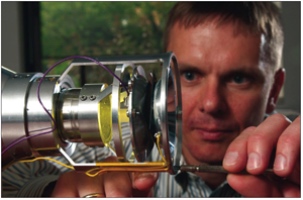Researchers at the National Superconducting Cyclotron Laboratory (NSCL) at Michigan State University have made new observations in different regions of the isotopic landscape by examining the nuclear structure of 64Ge and 36Mg.

Nuclei with equal proton (Z) and neutron (N) numbers are important in unravelling nuclear structure, in particular in the context of the shell model. Between 56Ni and 100Sn they exhibit a variety of shapes, evolving from spherical to prolate (cigar-shaped) to oblate (pancake-shaped) as the mass increases. Studies of transition rates between excited states and ground states in these nuclei provide important information to test shell-model predictions.

Image credit: NSCL.
One such experiment at NSCL has studied 64Ge (N = Z = 32), making use of the recoil distance method (RDM) to measure the lifetime of two excited states (Starosta et al. 2007.) This was only the second measurement of this kind conducted in this region of isotopes, and the first to use the RDM at a fast-fragmentation facility. The beam speed at NSCL, 10 times higher than in previous RDM studies, allows for greater precision and gives access to a range of previously unattainable isotopes.
The experiment used a variety of state-of-the-art techniques, including a plunger device developed at the University of Cologne for use with the RDM. The plunger device produced the 64Ge nuclei in reactions where a single neutron was knocked out of incident 65Ge nuclei in a beam that contained a mixture of rare isotopes. The RDM used high-resolution gamma-ray spectroscopy and the Doppler effect to determine the lifetime of the excited states. The results agree well with large-scale shell-model calculations for the two excited states studied, and show the promise of the techniques used.
Exotic nuclei far from N = Z, with too many neutrons, offer other possibilities for testing shell-model predictions. One area of interest is the “island of inversion” where around a dozen neutron-rich isotopes should exhibit shell orderings that differ from standard theoretical predictions.
Studies of magnesium isotopes have already placed 31–34Mg (Z = 12, N = 19–22) in the island. Now, for the first time, an experiment at NSCL has examined the shell structure of 36Mg which has as many as 24 neutrons (Gade et al. 2007). In this case, a secondary beam of 38Si collided with a beryllium target to create 36Mg on rare occasions: only 1 in 400,000 38Si nuclei yielded the desired 36Mg. Spectroscopic measurements of the first excited state confirmed shell-model predictions, placing 36Mg in the island of inversion as expected.





